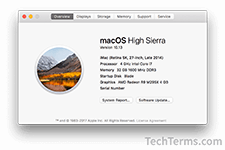High Sierra
High Sierra is the common name of macOS 10.13. It is the 14th version of Apple's desktop operating system, and follows Sierra, macOS 10.12. Apple released macOS High Sierra on September 25, 2017.
The similarity of the name "High Sierra" to "Sierra" is not coincidental, as it was designed to be a performance update rather than major feature update. Previous performance updates include Snow Leopard (which followed Leopard), Mountain Lion (which followed Lion), and El Capitan (which followed Yosemite).
The most notable performance improvement in High Sierra is the introduction of a new file system, called "Apple File System" or APFS. The new file system is designed to operate more efficiently on SSDs and other flash memory drives. It improves overall responsiveness and speeds up common tasks, such as copying files and calculating the size of a folder. It also includes native built-in encryption to protect data from unauthorized access. Finally, AFS makes system backups faster and more reliable.
High Sierra natively supports the High Efficiency Video Coding (HEVC) codec, which provides as good or better quality than previous codecs, while reducing file size by up to 40%. It also supports Apple's Metal 2 API, which takes advantage of modern GPUs and improves virtual reality rendering.
Apps updated in High Sierra include Photos, which adds photo organization options and provides new editing capabilities, Mail, which includes support for compressed messages, and Notes, which supports tables. Additionally, High Sierra makes it easier to share individual iCloud files and allows family members to share a single iCloud storage plan.
 Test Your Knowledge
Test Your Knowledge